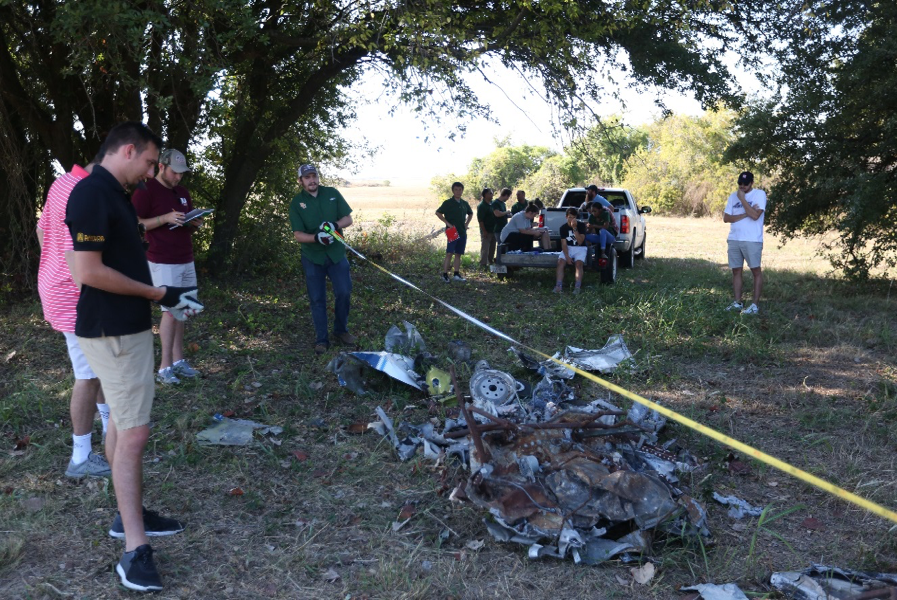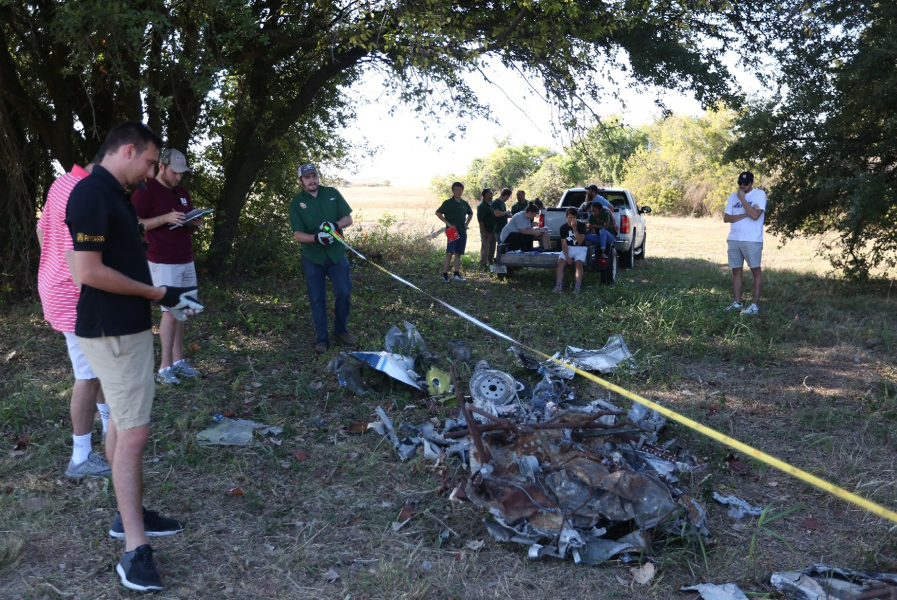Baylor Institute for Air Science (BIAS) Gains Accident Investigation Laboratory


Aviation sciences students examine reconstructed crash site being used in teaching principles of accident investigation.
Contact: Whitney Richter, Director of Marketing and Communications, Office of the Vice Provost for Research, 254-710-7539
Written by: Gary Stokes, Office of the Vice Provost for Research
WACO, Texas (October 24, 2018) – Baylor Aviation Sciences students now receive hands-on experience in aircraft accident investigation using wreckage from a light aircraft accident investigated by the National Transportation Safety Board.
The wreckage was obtained by Andy Olvis, an adjunct Aviation Sciences lecturer and NTSB air traffic investigator who was a part of the team that investigated the 2015 accident in which a family of four lost their lives. The crash occurred just eight miles from Olvis’s home near San Antonio. After investigators examined the wreckage in the field, it was taken to a nearby wrecking yard where it sat for months. Olvis passed the yard nearly every day as he drove his son to school.
“The airplane was not insured, so [the owner of the wrecking yard] actually owned the airplane because it sat on his lot for so long,” Olvis said. “After about a year of going back and forth and seeing the airplane there, I stopped in and asked if he would be willing to donate it to [Baylor]. He said, ‘If you come get it, you can have it.’ It took us about a year to work out the details and logistics of where the lab would actually be.”
Research Professor and BIAS Director Dr. Trey Cade said the accident investigation lab adds greatly to the Aviation Sciences program, especially so in that the wreckage was accompanied by reams of documentation from the NTSB investigation that allowed for an accurate and detailed reconstruction of the accident scene.
Olvis explains that early in the semester, his lectures focus on the NTSB’s organization and the techniques used in investigating aircraft accidents. The lab gives students a rare, hands-on opportunity to apply what they’ve learned in class. But the lab also adds another dimension to their experience that no textbook or lecture could provide—a deeper appreciation for the human cost these tragedies inflict.
“It’s shocking seeing an airplane crash, all the bits and pieces. It’s shocking even when you see it in pictures in a lecture. But when you go out and see the airplane, and you recognize that there is no cabin, and you see the frame with four seats, and you realize there were four humans, four people were sitting in those seats, and now they’re gone, it really impresses on you the need to do a great job. You need to provide answers to the family. There are people looking to you to provide them with answers about their loved ones,” Olvis said.
The lingering toll air crashes take on victims’ families and loved ones is a particular point of empathy for Olvis: his father was a crewmember aboard a U.S. Air Force training flight that went down in California. “When I was young I always wanted to know what happened to my dad; I always wondered about the accident. I knew he died in a plane crash in the United States Air Force, but that was it.”
Olvis emphasized that the lab is a work-in-progress. This fall the lab will be improved to make the site even more representative of the original accident scene. And Olvis says he plans to implement an insightful suggestion made by one of his students.
“I can’t give enough credit to one of my students who suggested that we incorporate a cognitive interview technique that we talk about in class; I’d never thought of that. So we’re going to have witnesses [at the lab] where the students can go out, walk the accident scene, and interview people,” Olvis said. “We’ll script it out and each witness’s story will be different. The student-investigator will have to figure out what the true and accurate account is. It’s going to be a really exciting time.”
Student response to the lab was overwhelmingly positive after the lab’s first semester; some even expressed interest in becoming investigators.
“They mostly have another year to go before graduating, but they ask about how to get started in the NTSB,” Olvis said. “I am more than happy to tell them about that.”